Identifying Antibiotic Use Targets for the Management of Antibiotic Resistance Using an Extended-Spectrum β-Lactamase-Producing Escherichia coli Case: A Threshold Logistic Modeling Approach
Abstract
:1. Introduction
2. Results
2.1. Defining a Critical Level of Pathogen Incidence Rates
2.2. Threshold Logistic Method
2.3. Risk Scores
2.4. What-If Scenarios
3. Discussion
4. Methods
4.1. Study Design and Population
4.2. Microbiology and Pharmacy Data
4.3. Modeling and Statistical Analysis
4.3.1. Defining a Critical Level of Pathogen Incidence Rate
4.3.2. Threshold Logistic Method
Author Contributions
Funding
Institutional Review Board Statement
Informed Consent Statement
Data Availability Statement
Conflicts of Interest
References
- Aldeyab, M.A.; López-Lozano, J.M.; Gould, I.M. Global antibiotics use and resistance. In Global Pharmaceutical Policy; Babar, Z.U.D., Ed.; Palgrave Macmillan: Singapore, 2020; pp. 331–344. ISBN 978-981-15-2723-4. [Google Scholar]
- O’Neill, J. Antimicrobial Resistance: Tackling a Crisis for the Health and Wealth of Nations. The Review on Antimicrobial Resistance. 2014. Available online: https://amr-review.org/Publications.html (accessed on 3 June 2022).
- Antimicrobial Resistance Collaborators. Global burden of bacterial antimicrobial resistance in 2019: A systematic analysis. Lancet 2022, 399, 629–655. [Google Scholar] [CrossRef]
- Smith, R.; Coast, J. The true cost of antimicrobial resistance. BMJ 2013, 346, f1493. [Google Scholar] [CrossRef]
- Laxminarayan, R.; Duse, A.; Wattal, C.; Zaidi, A.K.; Wertheim, H.F.; Sumpradit, N.; Vlieghe, E.; Hara, G.L.; Gould, I.M.; Goossens, H.; et al. Antibiotic resistance-the need for global solutions. Lancet Infect. Dis. 2013, 13, 1057–1098. [Google Scholar] [CrossRef]
- Hecker, M.T.; Aron, D.C.; Patel, N.P.; Lehmann, M.K.; Donskey, C.J. Unnecessary use of antimicrobials in hospitalized patients: Current patterns of misuse with an emphasis on the antianaerobic spectrum of activity. Arch. Intern. Med. 2003, 163, 972–978. [Google Scholar] [CrossRef]
- Davey, P.; Marwick, C.A.; Scott, C.L.; Charani, E.; McNeil, K.; Brown, E.; Gould, I.M.; Ramsay, C.R.; Michie, S. Interventions to improve antibiotic prescribing practices for hospital inpatients. Cochrane Database Syst. Rev. 2017, 2, CD003543. [Google Scholar] [CrossRef]
- Plachouras, D.; Kärki, T.; Hansen, S.; Hopkins, S.; Lyytikäinen, O.; Moro, M.L.; Reilly, J.; Zarb, P.; Zingg, W.; Kinross, P.; et al. Antimicrobial use in European acute care hospitals: Results from the second point prevalence survey (PPS) of healthcare-associated infections and antimicrobial use, 2016 to 2017. Euro Surveill. 2018, 23, 1800393. [Google Scholar] [CrossRef]
- Nathwani, D.; Varghese, D.; Stephens, J.; Ansari, W.; Martin, S.; Charbonneau, C. Value of hospital antimicrobial stewardship programs [ASPs]: A systematic review. Antimicrob. Resist. Infect. Control. 2019, 8, 35. [Google Scholar] [CrossRef]
- Austin, D.J.; Kristinsson, K.G.; Anderson, R.M. The relationship between the volume of antimicrobial consumption in human communities and the frequency of resistance. Proc. Natl. Acad. Sci. USA 1999, 96, 1152–1156. [Google Scholar] [CrossRef]
- Jirjees, F.J.; Al-Obaidi, H.J.; Sartaj, M.; ConlonBingham, G.; Farren, D.; Scott, M.G.; Gould, I.M.; López-Lozano, J.M.; Aldeyab, M.A. Antibiotic Use and Resistance in Hospitals: Time-Series Analysis Strategy for Determining and Prioritising Interventions. Hosp. Pharm. Eur. 2020, 95, 13–19. Available online: https://hospitalpharmacyeurope.com/news/reviews-research/antibiotic-use-and-resistance-in-hospitals-time-series-analysis-strategy-for-determining-and-prioritising-interventions/ (accessed on 11 May 2022).
- Lopez-Lozano, J.M.; Lawes, T.; Nebot, C.; Beyaert, A.; Bertrand, X.; Hocquet, D.; Aldeyab, M.; Scott, M.; Conlon-Bingham, G.; Farren, D. A nonlinear time-series analysis approach to identify thresholds in associations between population antibiotic use and rates of resistance. Nat. Microbiol. 2019, 4, 1160–1172. [Google Scholar] [CrossRef]
- Hayajneh, W.A.; Al-Azzam, S.; Yusef, D.; Lattyak, W.J.; Lattyak, E.A.; Gould, I.; López-Lozano, J.M.; Conway, B.R.; Conlon-Bingham, G.; Aldeyab, M.A. Identification of thresholds in relationships between specific antibiotic use and carbapenem-resistant Acinetobacter baumannii (CRAb) incidence rates in hospitalized patients in Jordan. J. Antimicrob. Chemother. 2021, 76, 524–530. [Google Scholar] [CrossRef]
- Davey, P.; Brown, E.; Fenelon, L.; Finch, R.; Gould, I.; Hartman, G.; Holmes, A.; Ramsay, C.; Taylor, E.; Wilcox, M.; et al. Interventions to improve antibiotic prescribing practices for hospital inpatients. Cochrane Database Syst. Rev. 2005, 4, CD003543. [Google Scholar]
- Aldeyab, M.A.; Harbarth, S.; Vernaz, N.; Kearney, M.P.; Scott, M.G.; Darwish Elhajji, F.W.; Aldiab, M.A.; McElnay, J.C. The impact of antibiotic use on the incidence and resistance pattern of extended-spectrum beta-lactamase-producing bacteria in primary and secondary healthcare settings. Br. J. Clin. Pharmacol. 2012, 74, 171–179. [Google Scholar] [CrossRef]
- Slimings, C.; Riley, T.V. Antibiotics and hospital-acquired Clostridium difficile infection: Update of systematic review and meta-analysis. J. Antimicrob. Chemother. 2014, 69, 881–891. [Google Scholar] [CrossRef]
- Tacconelli, E.; De Angelis, G.; Cataldo, M.A.; Pozzi, E.; Cauda, R. Does antibiotic exposure increase the risk of methicillin-resistant Staphylococcus aureus (MRSA) isolation? A systematic review and meta-analysis. J. Antimicrob. Chemother. 2008, 61, 26–38. [Google Scholar] [CrossRef]
- Lipsitch, M.; Samore, M.H. Antimicrobial use and antimicrobial resistance: A population perspective. Emerg. Infect. Dis. 2002, 8, 347–354. [Google Scholar] [CrossRef]
- Levy, S.B. Balancing the drug-resistance equation. Trends Microbiol. 1994, 2, 341–342. [Google Scholar] [CrossRef]
- Yusef, D.; Hayajneh, W.A.; Bani Issa, A.; Haddad, R.; Al-Azzam, S.; Lattyak, E.A.; Lattyak, W.J.; Gould, I.; Conway, B.R.; Bond, S.; et al. Impact of an antimicrobial stewardship programme on reducing broad-spectrum antibiotic use and its effect on carbapenem-resistant Acinetobacter baumannii (CRAb) in hospitals in Jordan. J. Antimicrob. Chemother. 2021, 76, 516–523. [Google Scholar] [CrossRef]
- Conlon-Bingham, G.M.; Aldeyab, M.; Scott, M.; Kearney, M.P.; Farren, D.; Gilmore, F.; McElnay, J. Effects of antibiotic cycling policy on incidence of healthcare-associated MRSA and Clostridioides difficile infection in secondary healthcare settings. Emerg. Infect. Dis. 2019, 25, 52–62. [Google Scholar] [CrossRef]
- Aldeyab, M.A.; Monnet, D.L.; López-Lozano, J.M.; Hughes, C.M.; Scott, M.G.; Kearney, M.P.; Magee, F.A.; McElnay, J.C. Modelling the impact of antibiotic use and infection control practices on the incidence of hospital-acquired methicillin-resistant Staphylococcus aureus: A time-series analysis. J. Antimicrob. Chemother. 2008, 62, 593–600. [Google Scholar] [CrossRef]
- Aldeyab, M.A.; Harbarth, S.; Vernaz, N.; Kearney, M.P.; Scott, M.G.; Funston, C.; Savage, K.; Kelly, D.; Aldiab, M.A.; McElnay, J.C. Quasiexperimental study of the effects of antibiotic use, gastric acid-suppressive agents, and infection control practices on the incidence of Clostridium difficile-associated diarrhea in hospitalized patients. Antimicrob. Agent. Chemother. 2009, 53, 2082–2088. [Google Scholar] [CrossRef]
- Monnet, D.L.; MacKenzie, F.M.; López-Lozano, J.M.; Beyaert, A.; Camacho, M.; Wilson, R.; Stuart, D.; Gloud, I.M. Antimicrobial drug use and methicillin-resistant Staphylococcus aureus, Aberdeen, 1996–2000. Emerg. Infect. Dis. 2004, 10, 1432–1441. [Google Scholar] [CrossRef]
- Vernaz, N.; Huttner, B.; Muscionico, D.; Beyaert, A.; Camacho, M.; Wilson, R.; Stuart, D.; Gould, I.M. Modelling the impact of antibiotic use on antibiotic-resistant Escherichia coli using population-based data from a large hospital and its surrounding community. J. Antimicrob. Chemother. 2011, 66, 928–935. [Google Scholar] [CrossRef]
- Vernaz, N.; Sax, H.; Pittet, D.; Bonnabry, P.; Schrenzel, J.; Harbarth, S. Temporal effects of antibiotic use and hand rub consumption on the incidence of MRSA and Clostridium difficile. J. Antimicrob. Chemother. 2008, 62, 601–607. [Google Scholar] [CrossRef]
- Kaier, K.; Hagist, C.; Frank, U.; Conrad, A.; Meyer, E. Two time-series analyses of the impact of antibiotic consumption and alcohol-based hand disinfection on the incidences of nosocomial methicillin-resistant Staphylococcus aureus infection and Clostridium difficile infection. Infect. Control. Hosp. Epidemiol. 2009, 30, 346–353. [Google Scholar] [CrossRef]
- Lawes, T.; López-Lozano, J.-M.; Nebot, C.A.; Macartney, G.; Subbarao-Sharma, R.; Dare, C.; Wares, K.D.; Gould, I.M. Effects of national antibiotic stewardship and infection control strategies on hospital-associated and community-associated meticillin-resistant Staphylococcus aureus infections across a region of Scotland: A non-linear time-series study. Lancet Infect. Dis. 2015, 15, 1438–1449. [Google Scholar] [CrossRef]
- Lawes, T.; Lopez-Lozano, J.M.; Nebot, C.; Macartney, G.; Subbarao-Sharma, R.; Dare, C.R.; Wares, K.D.; Gould, I.M. Turning the tide or riding the waves? Impacts of antibiotic stewardship and infection control on MRSA strain dynamics in a Scottish region over 16 years: Non-linear time series analysis. BMJ Open. 2015, 5, e006596. [Google Scholar] [CrossRef]
- Lawes, T.; López-Lozano, J.-M.; A Nebot, C.; Macartney, G.; Subbarao-Sharma, R.; Wares, K.D.; Sinclair, C.; Gould, I.M. Effect of a national 4C antibiotic stewardship intervention on the clinical and molecular epidemiology of Clostridium difficile infections in a region of Scotland: A non-linear time-series analysis. Lancet Infect. Dis. 2017, 17, 194–206. [Google Scholar] [CrossRef]
- Tacconelli, E.; Carrara, E.; Savoldi, A.; Harbarth, S.; Mendelson, M.; Monnet, D.L.; Pulcini, C.; Kahlmeter, G.; Kluytmans, J.; Carmeli, Y.; et al. Discovery, research, and development of new antibiotics: The WHO priority list of antibiotic-resistant bacteria and tuberculosis. Lancet Infect. Dis. 2018, 18, 318–327. [Google Scholar] [CrossRef]
- Aldeyab, M.A.; McElnay, J.C.; Scott, M.G.; Darwish Elhajji, F.W.; Kearney, M.P. Hospital antibiotic use and its relationship to age-adjusted comorbidity and alcohol-based hand rub consumption. Epidemiol. Infect. 2014, 142, 404–408. [Google Scholar] [CrossRef]
- Aldeyab, M.A.; McElnay, J.C.; Scott, M.G.; Lattyak, W.J.; Darwish Elhajji, F.W.; Aldiab, M.A.; Magee, F.A.; Conlon, G.; Kearney, M.P. A modified method for measuring antibiotic use in healthcare settings: Implications for antibiotic stewardship and benchmarking. J. Antimicrob. Chemother. 2014, 69, 1132–1141. [Google Scholar] [CrossRef]
- EUCAST Technical Guidance on the Use of the Combination Disk Test (CDT) for Confirmation of ESBL in Enterobacterales. Available online: https://www.eucast.org/fileadmin/src/media/PDFs/EUCAST_files/General_documents/Miscellaneous/Guidance_document_Confirmation_of_ESBL.pdf (accessed on 25 March 2022).
- WHO Collaborating Centre for Drug Statistics Methodology. Guidelines for ATC Classification and DDD Assignment, 2022. Oslo; 2021. Available online: https://www.whocc.no/filearchive/publications/2022_guidelines_web.pdf (accessed on 11 May 2022).
- WHO Report on Surveillance of Antibiotic Consumption: 2016–2018 Early Implementation; Licence: CC BY-NC-SA 3.0 IGO; World Health Organization: Geneva, Switzerland, 2018.
- Friedman, J. Multivariate adaptive regression splines. Ann. Statist. 1991, 19, 1–67. [Google Scholar] [CrossRef]
- Hastie, T.; Tibshirani, R. Generalized Additive Models; Chapman & Hall: London, UK, 1990. [Google Scholar]
- Liu, L.-M. Time Series Analysis and Forecasting, 2nd ed.; Scientific Computing Associates Corp.: River Forest, IL, USA, 2009. [Google Scholar]
- Neter, J.; Wasserman, W.; Kutner, M.H. Applied Linear Statistical Models, 3rd ed.; Irwin: New York, NY, USA, 1990. [Google Scholar]
- Cox, D.R. The regression analysis of binary sequences (with discussion). J. R. Stat. Soc. B 1958, 20, 215–242. [Google Scholar]
- Maronna, R.A.; Martin, R.D.; Yohai, V.J.; Salibián-Barrera, M. Robust Statistics: Theory and Methods; John Wiley & Sons, Ltd.: Chichester, UK, 2006. [Google Scholar]
- Huber, P.J.; Ronchetti, E.M. Robust Statistics, 2nd ed.; Wiley: New York, NY, USA, 2009. [Google Scholar]
- Youden, W.J. Index for rating diagnostic tests. Cancer 1950, 3, 32–35. [Google Scholar] [CrossRef]
- Schisterman, E.F.; Perkins, N.J.; Liu, A.; Bondell, H. Optimal cut-point and its corresponding Youden Index to discriminate individuals using pooled blood samples. Epidemiology 2005, 16, 73–81. [Google Scholar] [CrossRef]
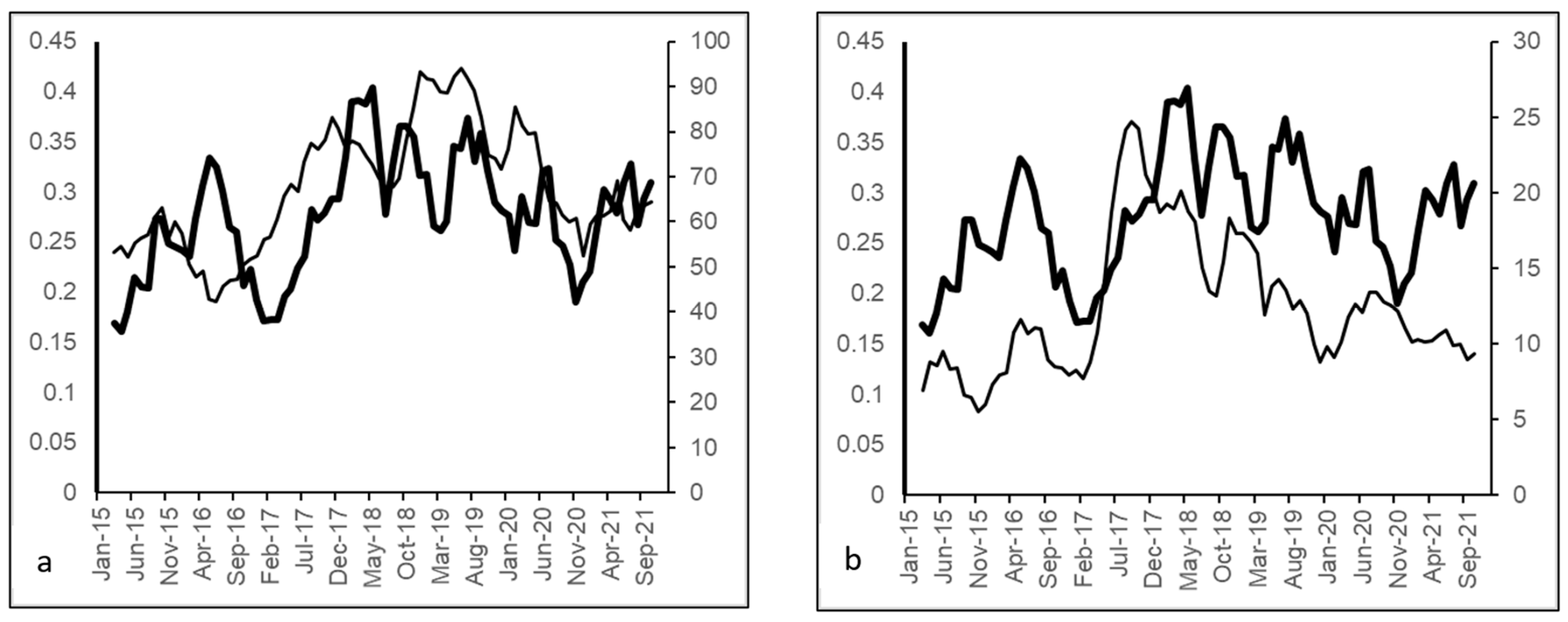
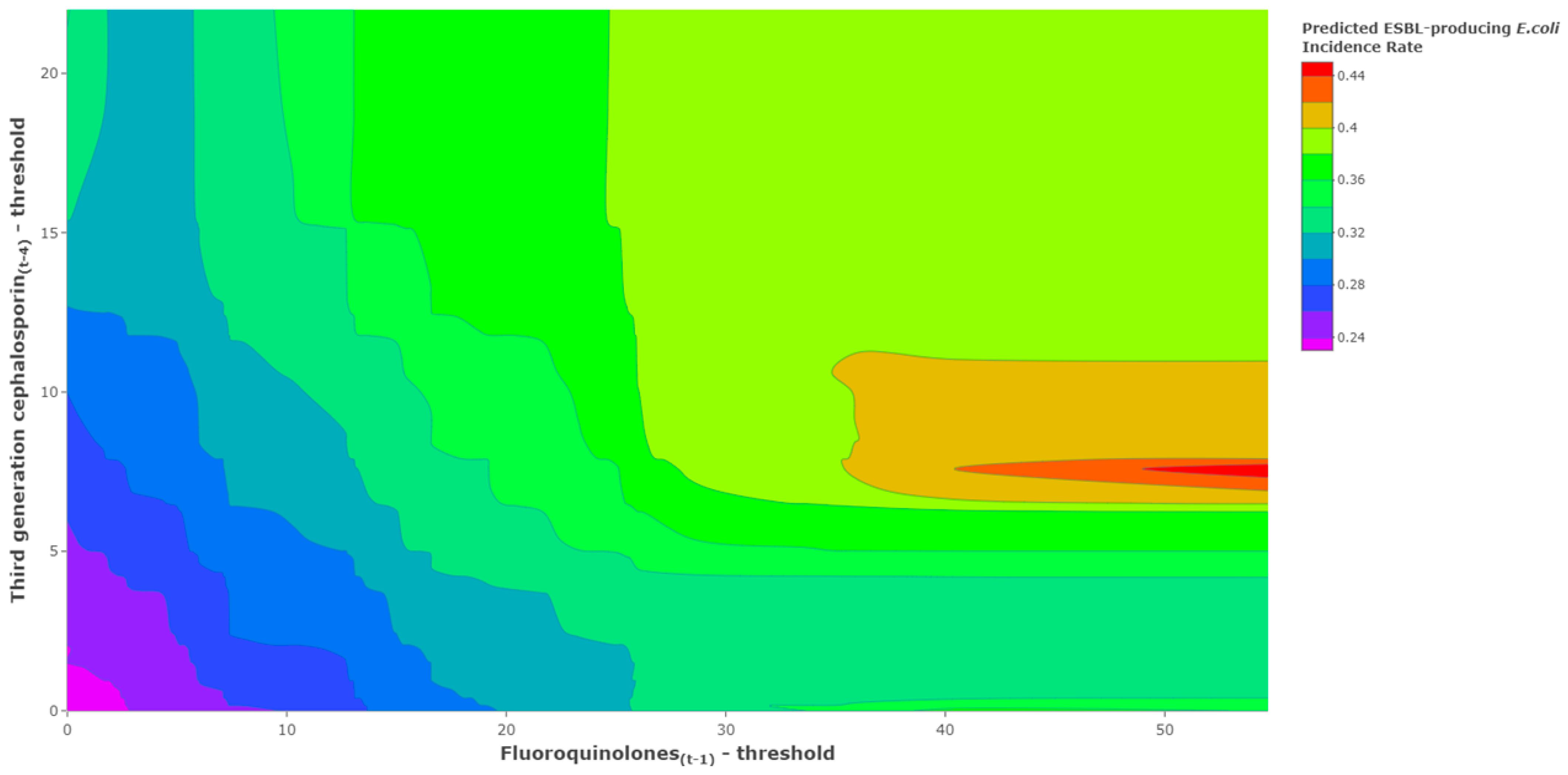
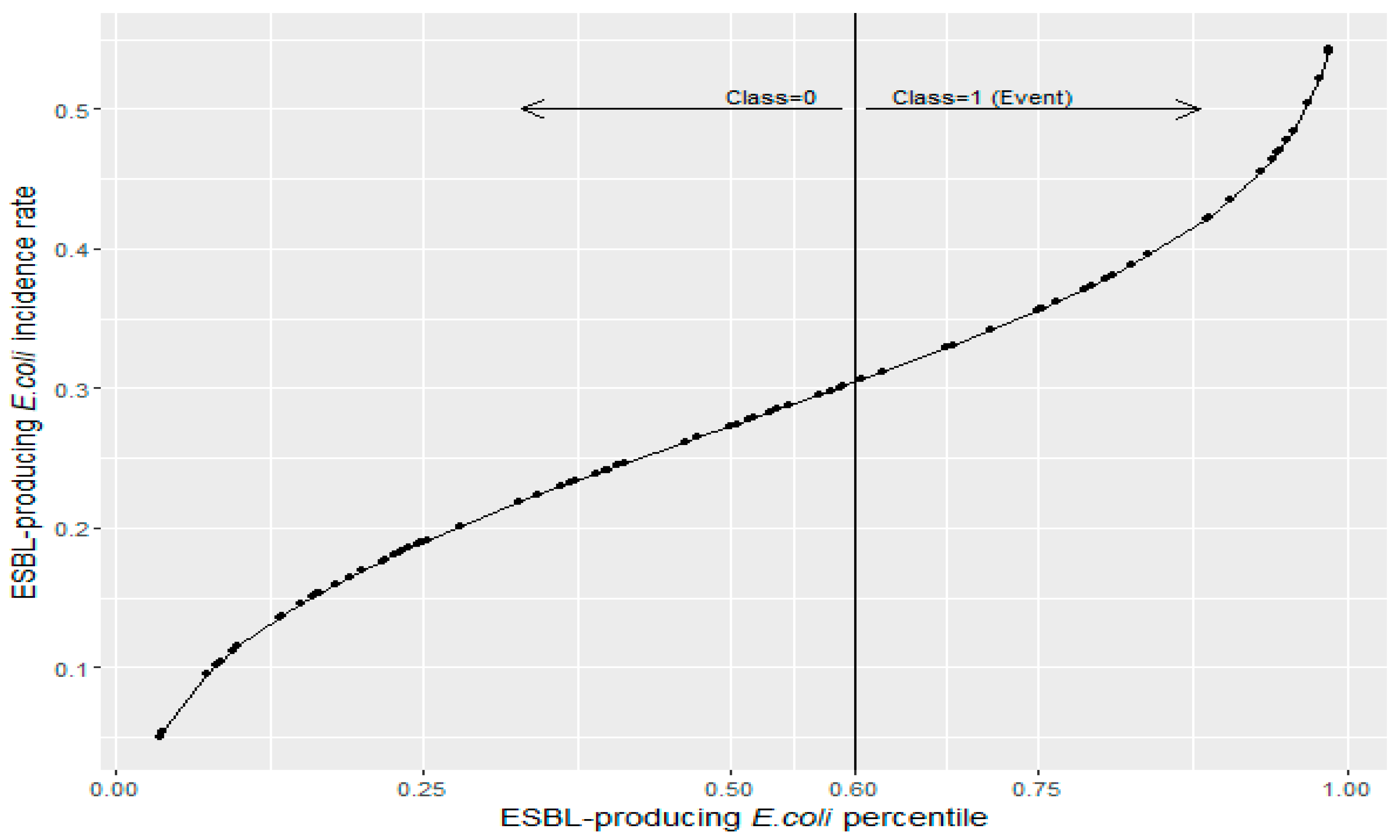
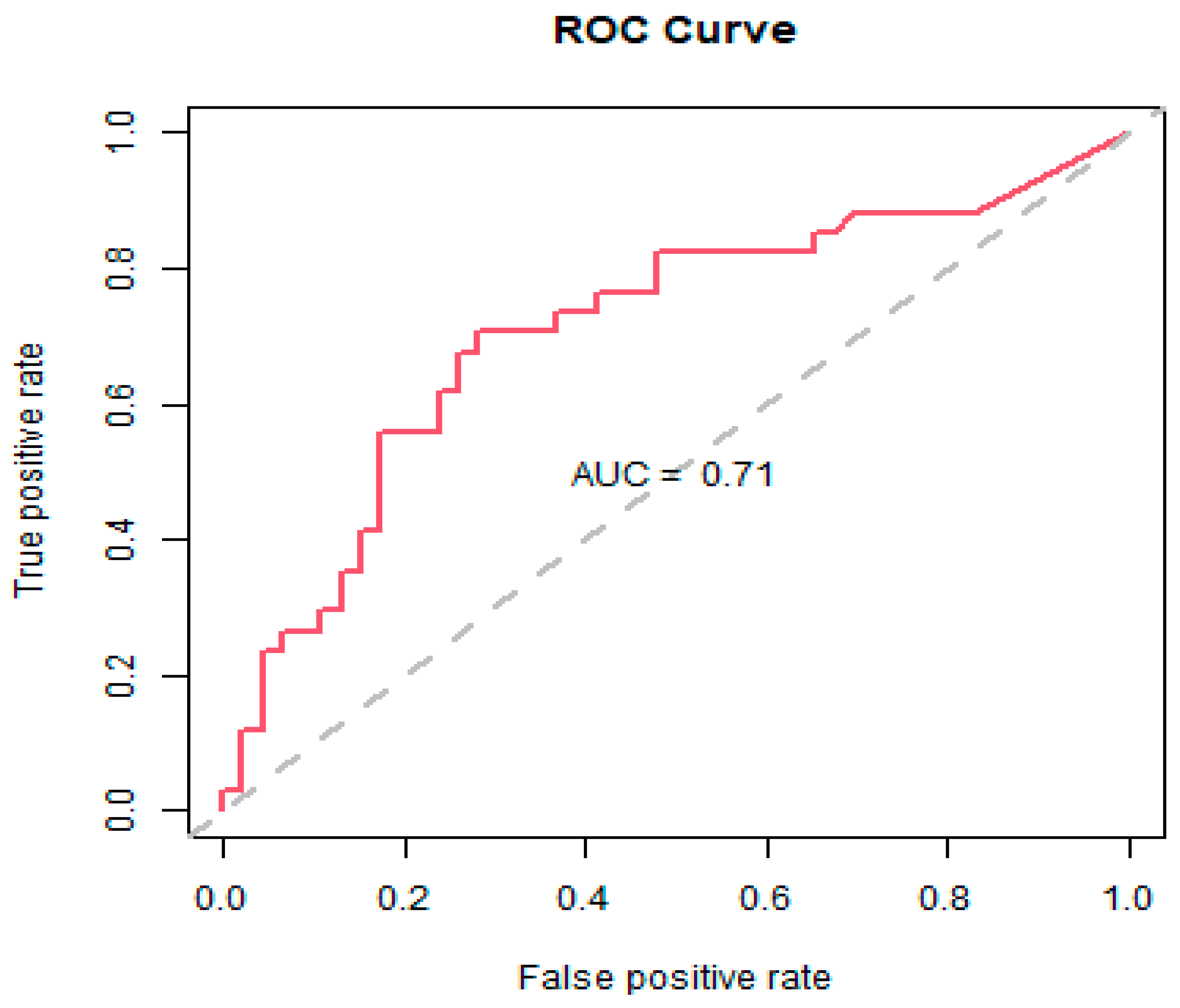

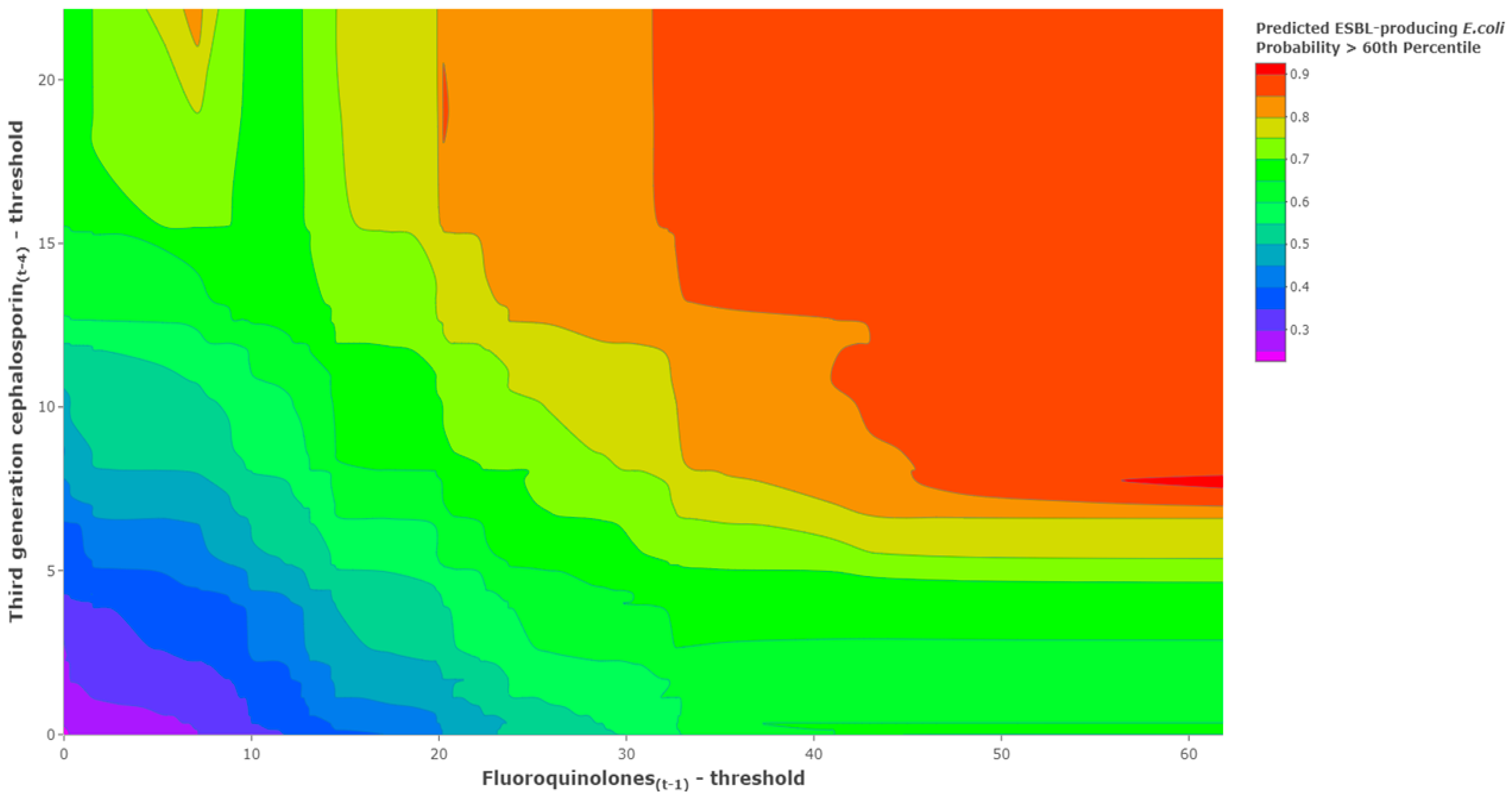
| Predictor Variable | Lag | Median Use (IQR) | Threshold (95% Confidence Limit) * | Relation to Threshold | Coefficient (95% CI) | p-Value | Odds Ratio (95% CI) |
|---|---|---|---|---|---|---|---|
| Constant | NA | NA | NA | NA | −1.177 (−1.902 to −0.451) | 0.0034 | 0.279 (0.119 to 0.656) |
| Fluoroquinolone use (DDD/1000 OBD) | 1 | 64.55 (53.58–76.39) | 61.142 (55.96 to 68.27) | Above | 0.045 (0.005 to 0.085) | 0.0293 | 1.045 (1.004 to 1.088) |
| Third-generation cephalosporin use (DDD/1000 OBD) | 4 | 10.76 (7.90–14.9) | 9.159 (8.75 to 11.40) | Above | 0.108 (0.004 to 0.211) | 0.0414 | 1.119 (1.007 to 1.244) |
| Date | ESBL-Producing E. coli Observed Above 60th Percentile (0.288) | Fluoroquinolone Use (DDD/1000 OBD) at Lag 1 (Threshold-Adjusted) | Third-Generation Cephalosporin Use (DDD/1000 OBD) at Lag 4 (Threshold-Adjusted) | Predicted ESBL-Producing E. coli Level * | Predicted ESBL-Producing E. coli Level + 1 Standard Deviation (SD) * | Predicted Probability ESBL-Producing E. coli >60th Percentile | Coded Alert Signal |
|---|---|---|---|---|---|---|---|
| January | Below | 0.00 | 5.07 | 0.2595 | 0.2799 | 0.3472 | Medium |
| February | Below | 0.00 | 5.52 | 0.2620 | 0.2823 | 0.3585 | Medium |
| March | Below | 0.00 | 1.11 | 0.2386 | 0.2589 | 0.2578 | Medium |
| April | Above | 32.22 | 1.12 | 0.3142 | 0.3346 | 0.5949 | High |
| May | Above | 7.70 | 2.24 | 0.2446 | 0.2649 | 0.3563 | Medium |
| June | Below | 0.00 | 0.00 | 0.2327 | 0.2530 | 0.2356 | Low |
| July | Below | 0.00 | 0.82 | 0.2370 | 0.2574 | 0.2519 | Medium |
| August | Above | 10.07 | 1.71 | 0.2424 | 0.2627 | 0.3675 | Medium |
| September | Above | 0.00 | 0.57 | 0.2357 | 0.2561 | 0.2469 | Medium |
| October | Below | 0.00 | 2.65 | 0.2467 | 0.2671 | 0.2908 | Medium |
| November | Below | 12.62 | 1.54 | 0.2501 | 0.2705 | 0.3900 | Medium |
| December | Below | 5.26 | 2.23 | 0.2445 | 0.2649 | 0.3316 | Medium |
| ESBL-Producing E. coli Incidence Rate Observed Above and Below the 60th Percentile | |||
|---|---|---|---|
| Above | Below | ||
| Coded Alert Signal | Low (<0.24) | 5 | 14 (2.8:1) |
| Medium | 12 | 24 | |
| High (>0.70) | 17 (2.1:1) | 8 | |
| Date | Fluoroquinolone Use (DDD/1000 OBD) at Lag 1 * | Third-Generation Cephalosporin Use (DDD/1000 OBD) at Lag 4 | Predicted ESBL-Producing E. coli Level ** | Predicted ESBL-Producing E. coli Level + 1 Standard Deviation (SD) ** | Predicted Probability ESBL-Producing E. coli > 60th Percentile | Coded Alert Signal |
|---|---|---|---|---|---|---|
| January 2022 | 75.15 ↑ | 5.82 ↓ | 0.2467 | 0.2670 | 0.3658 | Medium |
| February 2022 | 0.00 | 10.28 ↑ | 0.2386 | 0.2589 | 0.2580 | Medium |
| March 2022 | 0.00 | 6.43 ↓ | 0.2327 | 0.2530 | 0.2356 | Low |
| April 2022 | 0.00 | 12.83 ↑ | 0.2521 | 0.2725 | 0.3140 | Medium |
Publisher’s Note: MDPI stays neutral with regard to jurisdictional claims in published maps and institutional affiliations. |
© 2022 by the authors. Licensee MDPI, Basel, Switzerland. This article is an open access article distributed under the terms and conditions of the Creative Commons Attribution (CC BY) license (https://creativecommons.org/licenses/by/4.0/).
Share and Cite
Aldeyab, M.A.; Bond, S.E.; Conway, B.R.; Lee-Milner, J.; Sarma, J.B.; Lattyak, W.J. Identifying Antibiotic Use Targets for the Management of Antibiotic Resistance Using an Extended-Spectrum β-Lactamase-Producing Escherichia coli Case: A Threshold Logistic Modeling Approach. Antibiotics 2022, 11, 1116. https://doi.org/10.3390/antibiotics11081116
Aldeyab MA, Bond SE, Conway BR, Lee-Milner J, Sarma JB, Lattyak WJ. Identifying Antibiotic Use Targets for the Management of Antibiotic Resistance Using an Extended-Spectrum β-Lactamase-Producing Escherichia coli Case: A Threshold Logistic Modeling Approach. Antibiotics. 2022; 11(8):1116. https://doi.org/10.3390/antibiotics11081116
Chicago/Turabian StyleAldeyab, Mamoon A., Stuart E. Bond, Barbara R. Conway, Jade Lee-Milner, Jayanta B. Sarma, and William J. Lattyak. 2022. "Identifying Antibiotic Use Targets for the Management of Antibiotic Resistance Using an Extended-Spectrum β-Lactamase-Producing Escherichia coli Case: A Threshold Logistic Modeling Approach" Antibiotics 11, no. 8: 1116. https://doi.org/10.3390/antibiotics11081116
APA StyleAldeyab, M. A., Bond, S. E., Conway, B. R., Lee-Milner, J., Sarma, J. B., & Lattyak, W. J. (2022). Identifying Antibiotic Use Targets for the Management of Antibiotic Resistance Using an Extended-Spectrum β-Lactamase-Producing Escherichia coli Case: A Threshold Logistic Modeling Approach. Antibiotics, 11(8), 1116. https://doi.org/10.3390/antibiotics11081116







